Fallen Enthusiast GPU Manufacturers
S3 Savage4

S3 continued to improve on the Savage3D's design, which ultimately led to the creation of Savage4. Many of the architecture's inherent problems were fixed, and by transitioning to 250 nm process technology, S3 was able to manufacture the Savage4 with relative ease.
When the Savage4 shipped in 1999, it faced strong competition from Nvidia's Riva TNT2 and 3dfx's Voodoo3. It was significantly slower than those other cards, but it offered a strong feature set and was typically sold at budget-friendly prices.
Image Credit: VGAMuseum.info
S3 Savage 2000

Later in 1999, S3 and well-known OEM Diamond Multimedia merged together to form a new company called SONICblue. S3 wanted to avoid the supply issues it faced with its other Savage graphics cards by using Diamond as a dedicated manufacturer. The two companies also wanted to increase profits from sales, which would ordinarily be split between S3 and several OEMs.
The joint venture's first product was the S3 Savage 2000. This new design featured dedicated transform and lighting hardware, which ultimately proved to be broken. It also used a faster quad-texture engine capable of placing four textures per clock cycle. The card featured numerous other enhancements to increase performance, and also came with 32 MB of SDRAM.
Performance tests showed that the S3 Savage 2000 was significantly faster than its predecessor. At times, it was even quick enough to catch Nvidia's flagship GeForce 256. The card had serious driver issues, however, and suffered from a few other defects that eroded its chances against more stable competition.
Image Credit: VGAMuseum.info
Stay on the Cutting Edge
Join the experts who read Tom's Hardware for the inside track on enthusiast PC tech news — and have for over 25 years. We'll send breaking news and in-depth reviews of CPUs, GPUs, AI, maker hardware and more straight to your inbox.
S3 Chrome
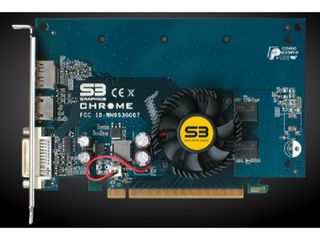
In 2001, S3 was split off from SONICblue and sold to VIA. As S3 faced strong competition in the discrete GPU market, VIA chose to cease development of add-in cards. Instead, the company used S3's graphics technology to enhance its motherboard chipsets. Several of these early iGPUs were essentially identical to the Savage4 and Savage 2000, and they were marketed under the Savage name. VIA rebranded the graphics engine as Chrome in subsequent platforms.
VIA tried to re-enter the add-in card market several times, but was unsuccessful due to competition from ATI/AMD and Nvidia. In 2011, the chipset vendor sold its shares of S3 to HTC. S3 still exists today, but it focuses on low-power graphics technology for integrated devices.
MORE: 23 Years Of Supercomputer Evolution
MORE: How Well Do Workstation Graphics Cards Play Games?
MORE: Gaming At 3840x2160: Is Your PC Ready For A 4K Display
3dfx Voodoo

The first 3dfx graphics card shipped in 1996 under the Voodoo brand, and it quickly became known as the fastest 3D accelerator available. One key advantage that 3dfx wielded was its Glide API. Because Glide was written exclusively to access 3dfx's products, it gave developers low-level access to the hardware, which naturally helped maximize performance. It also was less dependent on other platform components like host processing and memory.
Voodoo's only notable disadvantage was that it only accelerated 3D, meaning you needed a separate 2D controller as well.
Image Credit: VGAMuseum.info
3dfx Voodoo Rush
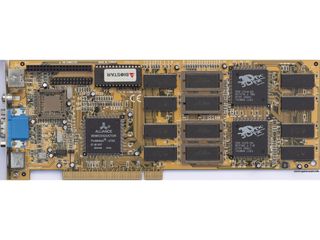
3dfx created its Voodoo Rush in 1997 by combining the Voodoo's 3D hardware with a third-party 2D controller on one card. 3dfx made deals with several companies that produced 2D accelerators, and as a result there was a lot of variation between Voodoo Rush cards.
Although the 3D hardware carried over from the original Voodoo's frame buffer processor and texture mapping unit, tests showed that the Voodoo Rush was typically slower. Part of this was attributable to the 2D and 3D subsystems sharing memory, which cut into the 3D accelerator's available bandwidth. But the Voodoo Rush also required more complex drivers, and an increase in overhead didn't help either.
Image Credit: VGAMuseum.info
3dfx Voodoo2

3dfx's Voodoo2 takes after the original Voodoo card, in that it is only capable of processing 3D graphic. The card used a single pixel pipeline the with two TMUs connected to between 8 to 12MB of vRAM. When it launched, the Voodoo2 was by far the fastest 3D accelerator on the market, and it would keep the performance crown for quite some time.
It should be noted that the Voodoo2 was also probably the most expensive graphics solution for gamers in 1998. The Voodoo2 was relatively expensive by itself, but it also required you to own a third-party 2D-accelerator for 2D games and Windows acceleration.
Image Credit: VGAMuseum.info
MORE: Best Graphics Cards
MORE: A Brief History Of Star Trek PC Games
MORE: In Pictures: 40 Unusual Computer Case Mods
3dfx Voodoo2 SLI

A unique feature of the Voodoo2 that helped it maintain dominance was 3dfx's Scan-Line Interleave technology. While multi-GPU configurations are fairly common in 2016, SLI represented the first time separate 3D cards could work cooperatively to improve performance.
3dfx Voodoo Banshee
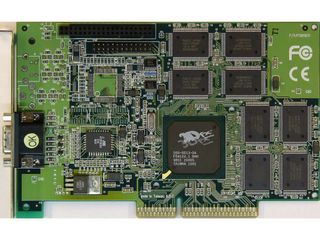
In 1998, 3dfx took another swing at the 2D/3D combo card, calling it Voodoo Banshee. The company pushed for greater integration. Its resulting single-chip solution contained a 2D engine developed in-house and most of the Voodoo2's hardware. The chip's 3D pipeline was limited to a single texture mapping unit for size reasons, but the other hardware units were exposed.
Greater integration made the Banshee more affordable than 3dfx's Voodoo2. And in single-textured tests, it kept up with the 3D-only card. More complex scenes weren't as forgiving though, and the Voodoo2's second TMU demonstrated its advantage. Still, the Banshee was regarded as a capable card.
Image Credit: VGAMuseum.info
3dfx Voodoo3
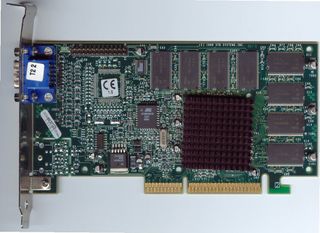
In 1999, 3dfx acquired STB Systems and implemented a new strategy. Its idea was to use STB's considerable manufacturing resources to produce 3dfx cards exclusively. The company would then sell its boards directly, enjoying greater margins in the process. This was similar to what S3 tried, and it worked about as well. Following the acquisition of STB Systems, 3dfx lost its board partners to Nvidia.
The first graphics card produced by 3dfx following its change in direction was the Voodoo3, which looked a lot like the Voodoo Banshee. The biggest difference between them was the Voodoo3's second TMU. 3dfx managed to operate the card's rendering hardware at higher clock rates than the Voodoo2, however, and it typically shipped with 16 MB of RAM. These factors allowed the Voodoo3 to nearly match the performance of two Voodoo2s in SLI. It was still limited to 16-bit color though, and due to strong competition from ATI and Nvidia, it would be 3dfx's last successful product.
Image Credit: VGAMuseum.info
3dfx Voodoo4
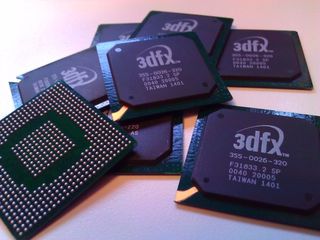
For the Voodoo4 (and 5), 3dfx improved its chip design to create the VSA-100 (Voodoo Scalable Architecture) processor. The VSA-100 had 32-bit data paths, eliminating a key disadvantage in image quality comparisons. 3dfx also changed the core configuration to expose two pixel pipelines per chip with one texture unit each (instead of the other way around).
VSA-100 connected to 32 MB of SDRAM over a 128-bit bus. The only model ever produced was the Voodoo4 4500, and few were ever sold.
-
apache_lives Voodoo II section for 3Dfx doesnt seem right - its talking about the Voodoo5 with a Voodoo5 picture...Reply -
IInuyasha74 Reply18732147 said:Kyro is missing!
I left Kyro and all PowerVR based graphics solutions out, because PowerVR is not a fallen GPU manufacturer. Technically, a company could still use PowerVR graphics on a GPU add-on card or as an integrated graphics solution.Intel did this a few years ago with its Atom-based systems. PowerVR also has a long list of graphics processors it has developed over the years, more than all of the companies listed above combined. More than enough to warrant a separate piece of its own when time permits. -
clonazepam I remember being so hyped about the Voodoo 6000 and its external power supply. Their marketing back then was fantastic. The box art was pretty amazing.Reply -
Realist9 I still remember the 3dfx voodoo2 and sli. When I finally got Jedi Knight Dark Forces II into "3d", it was awesome. Never will forget that.Reply -
clonazepam Reply18732836 said:I still remember the 3dfx voodoo2 and sli. When I finally got Jedi Knight Dark Forces II into "3d", it was awesome. Never will forget that.
A memory that really sticks out for me is when glide was out, and games had to be patched to opengl. We're talking about hundreds of MBs over dial-up.
I ended up selling my two Voodoo2s to an enthusiast around '99-00. -
DoDidDont 3dLabs?? The company was a leader for years in the professional graphics market, and considered the "choice" brand for professionals. They brought many innovations that still exist today under different guises. I remember Nvidia buying up all the Realizm 800's after the company was sold and broken up by Creative. Cant believe their GPU support site is still up and running... Nvidia and ATi had nothing that could come anywhere near the performance of the Realizm 800 the year it was launched.Reply -
Fixadent 3Dfx and the Voodoo 2 are still legends in the world of GPU's.Reply
I wish that 3Dfx still existed and competed with AMD and Nvidia. -
Fixadent Back in the late 1990's, I was awed at the graphics of Quake 2 running on a voodoo 2.Reply -
LORD_ORION I had a Diamond Vodoo 1, Mech Warrior 2 3dfx edition was so damn good.Reply
I also had a vodoo 5.... Heretic II was so heli-good with AA.
The cards were expensive and quickly fell behind in performance though... so poor investments. :(
Anyone remember the 3dfx commercials? ;)
Like the one when they are makinf advanced medical equipment and then... everyone stop, we're going to use this tech to make video game cards instead.
Most Popular


